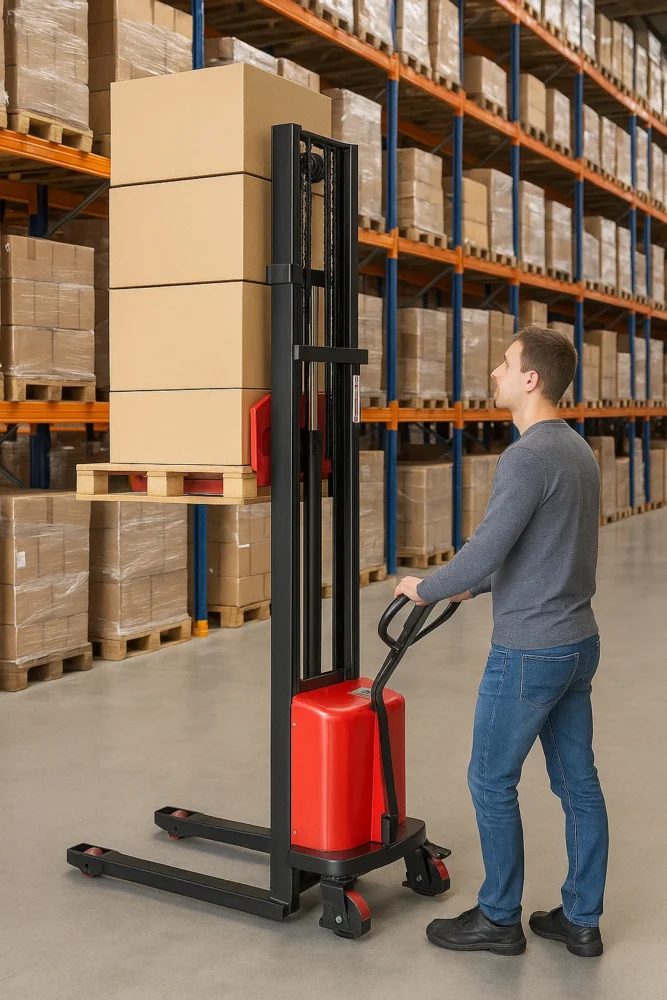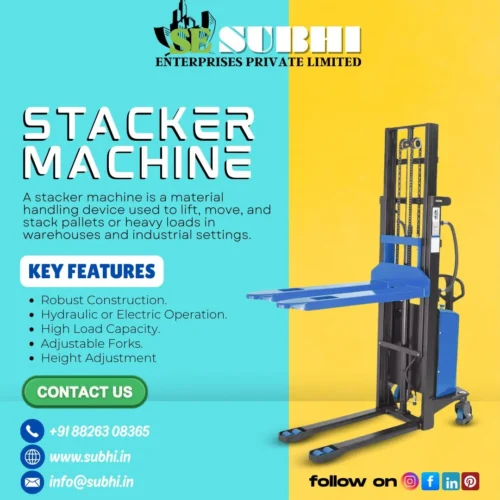Everything About Stacker Machines: Types, Benefits, and Uses
In the industrial and logistics sectors, safety, precision, and space optimization are absolute criticals. One of the stacker machine’s many function is to add efficiency towards these attributes. Whether you operate a warehouse, a manufacturing unit, or even a retail distribution center, stackers provide a smart and reliable solution to material handling and spatial integration.
In this guide, I plan to tell you everything need to know about stacker machines, their types and how they function, as well as their benefits and applications. Let’s get started.
What is a Stacker Machine?
Stacker machines are categorized as material handling equipment which does lifting, transporting and stacking of goods, pallets and containers. Stackers, unlike traditional forklifts, are designed for basic indoor functions and are compact and user-friendly.
Stackers fill the void between full-fledged forklifts and pallet jacks. They can be operated by hand or can be fully electric, which makes them popular in retails, warehouses, and even small manufacturing units and distribution centers.
Types of Stacker Machines
Depending on the power source, design, load capacity, and power or source, stackers are grouped into different types. Knowing these will guide you to which one you need.
1. Manual Stacker
Manual stackers are operated with the help of human power. They have their own hydraulic pump system for load lifting. These stackers work best for low intensity operations and smaller facilities.
Key Features:
- Economical
- No battery or power source needed
- Load capacity: Usually up to 1000 kg
- Lift height: 1.6 to 3 meters
2. Semi Electric Stacker
It is a type of stacker with an electric lift, however it does have manual push/pull movement. This type of machine finds the balance between cost and efficiency.
Key Features:
- Lift is electric, travel is manual
- Best for moderate loads and height
- Load capacity: 1000–1500 kg
- Lift height: Up to 3.5 meters
3. Fully Electric Stacker
Fully electric stackers, as which their name suggests, are battery powered for both lifting and moving the stacker. They are designed to be ergonomic in nature so as to reduce operator fatigue and increase productivity.
Key Features:
- Electric lift and travel
- Greater efficiency and productivity
- Load capacity: 1000–2000 kg
- Lift height: Up to 5.5 meters
4. Ride On Stacker
The operator can stand or sit on the ride-on stacker making it easier to operate from afar. This is ideal for long distance travel in large warehouses.
Key Features:
- Comfortable for long use
- Higher speed and efficiency
- Advanced safety and control features
5. Counterbalance Stacker
These stackers do not have front legs and use a counterweight to balance the load. This design allows them to handle closed pallets and loads without ground clearance.
Key Features:
- Forks facing up, selective straddle legs
- No straddle legs, full pallet access
- Suitable for tight spaces
- Compact and powerful

How Does a Stacker Work?
The working mechanism of a stacker machine depends on its type. However, the basic principles are quite straightforward:
- Lifting Mechanism : Stackers use hydraulic or electric systems to lift loads. In manual models, a hydraulic jack is pumped by hand. In electric versions, a motor powers the lifting.
- Movement : Manual stackers are moved by pushing or pulling. Electric stackers are controlled by handles or tillers that guide the frame into desired position, with movement enabled by electric motors.
- Control : Operating joysticks and tillers, or even push buttons, enable vertical and horizontal movement of the stacker.
- Braking and Safety : Most electric models include emergency stop buttons, anti-roll-back mechanisms, and automatic braking for enhanced safety.
Benefits of Using a Stacker Machine
Stacker machines offer several operational advantages that make them a must-have for modern material handling operations.
1. Spatial Efficiency
- Stackers are created for use in the tight spaces of a warehouse, such as narrow aisles, as well as seeking to maximize vertical storage aloft while simultaneously minimizing the warehouse footprint.
2. Improved Productivity
- Through faster unloading, loading and stacking, stackers can improve warehouse throughput and reduce downtime.
3. Cost-Effective
- Compared to forklifts, manual and semi-electric stackers come at a much lower upfront cost as well as reduced long term maintenance costs.
4. Improved Safety
- By aiding the reduction of workplace injuries, stackers help improve workplace safety. They are designed with protective features like overload protection, emergency stop buttons, and ergonomic handles.
5. Eco-Friendliness
- Inside areas where ventilation is limited, electric stackers have no emissions rendering them ideal. They are also suitable for eco-friendly operations.

Consider the following features when selecting a stacker machine for your operation:
1. Load capacity : Check if the stacker can lift the typical loads you work with.
2. Lift height : The ideal model is one that can lift to the height of your racks.
3. Battery life : Electric stackers need to have enduring batteries to guarantee uninterrupted battery powered work.
4. Build quality : Go for models made of steel and those whose parts are not easily damaged.
5. Maintenance : Opt for machines that do not require constant servicing and whose parts are easy to access.
6. Safety Features : Seek critical safety elements like emergency brakes, warning over load alarms and overload protection.
Applications of Stacker Equipments
Their usefulness is seen broadly because stackers can be used in various fields:
1. Warehousing and Logistics
- Stackers help to lift pallets, store items, and facilitate the loading and unloading of goods in small warehouses.
2. Retail and Supermarkets
- Great for placing merchandise on tall shelves, as well as keeping track of backroom stock.
3. Manufacturing Units
- They help in lifting and transporting raw materials and finished products from one workstation to another.
4. Cold Storage
- Electric load stackers are often used in controlled temperatures because they do not emit any pollutants.
6. Small Distribution Centers
- They are suitable for medium-sized operations because their small size and are efficient make them useful in congested areas.
Stacker Machines Maintenance
Regular care will extend the efficiency and safety of stacker machines alongside other general equipment. The following tips should be heavily considered:
Maintenance of Inspection : Periodic checks for worn out mechanical parts, loose attachments, and fluid leaks should always be undertaken.
Care Routine for Batteries : Avoid going below the charge limit and make sure they are fully charged.
Lubrication : The moving parts alongside the lifting chains ought to be greased regularly.
Testing of Brakes : Brakes ought to be tested frequently alongside emergency stop functionalities.
Maintenance of Cleanliness : Clean and dry stacking machines to avert the likelihood of rust forming alongside electrical fault issues.
Standards of Safety when operating Stacker Machines
Guidelines set have to be followed when using stackers since they can be dangerous if usage is done incorrectly. They include but are not limited to:
1. Manual Forklifts : Ensure that all operators of the manual forklifts stacked are well versed with using the equipment.
2. Load Restriction : Set upper limits that are never to be exceeded alongside rated load capacity.
3. Speed Restriction : Regions with congestion ought to be considered and movement controlled.
4. Properly Positioned For Avert Tipping : Center the loads to be placed on the machine to maintain balance.
5. Usage of Mirrors : Precaution ought to be taken not to block vision when driving and where an obstruction is provided, mirrors should be used or the aid of a spotter.
Why Invest In A Stacker Machine: Final Remarks
The use of stacker machines significantly reduces the cost associated with material handling. Moreover, stackers occupy a smaller area and are less expensive than forklifts which make them more advantageous in confined or indoor places. Thus, stackers are economically better than forklifts while providing greater productivity.
Selecting the right stacker will streamline logistical processes and improve productivity, irrespective of whether a company is installing new systems or retrofitting an existing warehouse. A trusted vendor offers precise evaluations which help identify the necessary criterions to achieve optimal results.
